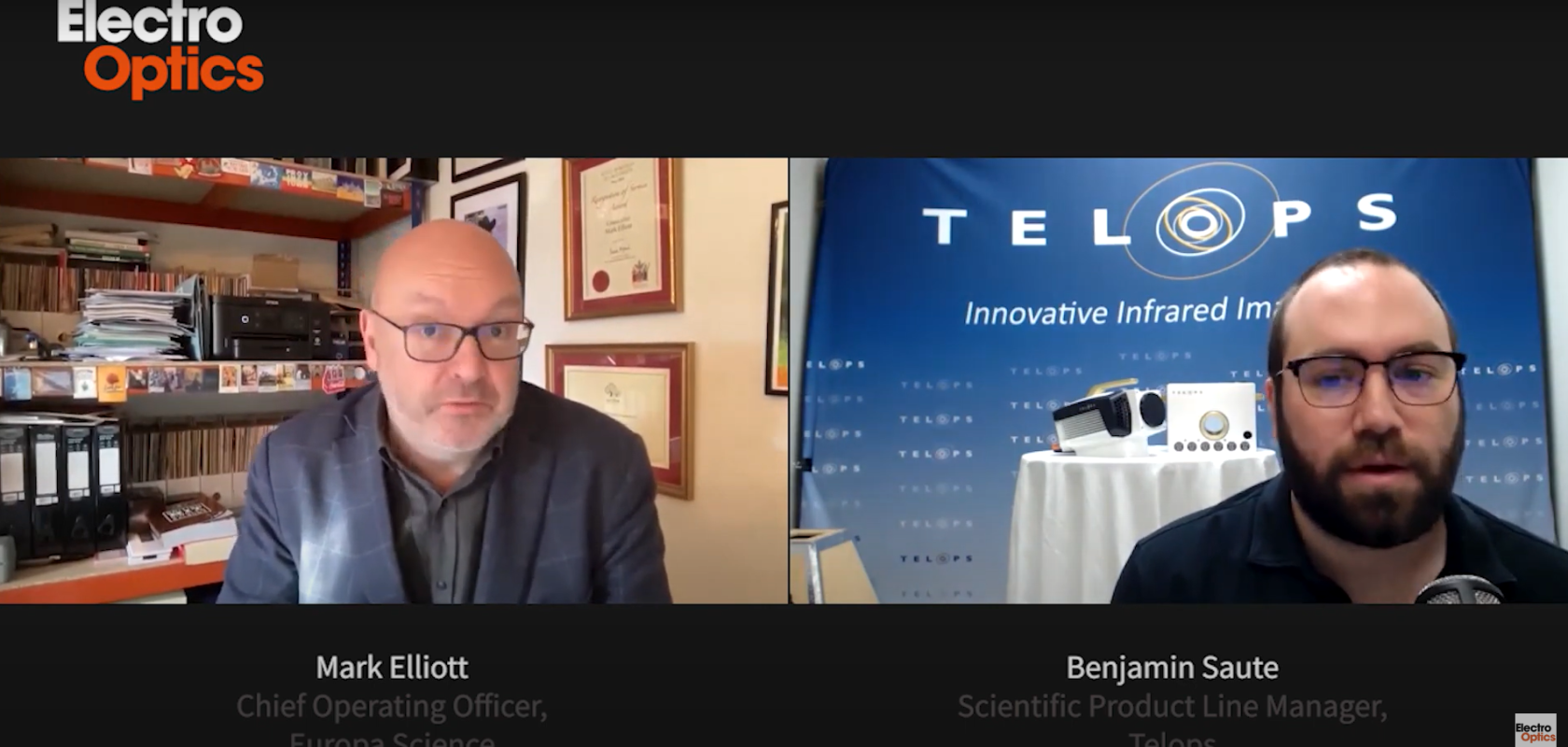Ben Saute, Product Line Manager, Scientific at Telops, shares a sneak preview of three new products coming from the firm this year and explains why the organisation is making customer understanding the core of its successful strategy. Watch the full video below.
What do you think first drew you to a career in photonics?
That's a good question. I had been interested in science from a young age, and was really encouraged by two excellent high school teachers to pursue a scientific career. That was my first introduction to physical sciences as a potential career.
Thinking back to your time at the University of Rhode Island, can you tell us how that was and how you have ended up in your current role at Telops?
I started at the University of Rhode Island as a chemistry major, and started independent research with some of the faculty there. My first exposure to photonics was in the form of spectroscopy; Raman spectroscopy, in particular. I did a lot of my graduate school work, developing techniques using Raman spectroscopy for really low-level pesticide detection.
That was my first introduction to the hardware around photonics, and I kind of fell in love with instrumentation, data analysis, and lasers. It was a really formative time in my career and, after that, I was able to get a job doing chemical detection; again using Raman and infrared spectroscopy. That transitioned into an interest in imaging technologies as well.
Eventually, I had some contact with telescopes through my previous job and I went for a visit to Telops, saw the Hyper-Cam and it was really an exciting technology. The rest is history – I joined the company and have been able to work with that technology ever since.
Was it the technology that specifically attracted you or was it also the culture of the organisation that you saw?
It was certainly both. Everyone is super-friendly in this company but, on the technology side, I was working with spectroscopy on a single-point basis – bringing the sample to the instruments and doing the measurements. The key difference with hyperspectral imaging is, of course, the fact it's an imaging technology. So, the first time I was able to see a full image where every single pixel has its own sort of infrared spectrum attached to it, I was really impressed with the utility of that kind of measurement and the things you can do – gas detection or chemical analysis of a scene – it was really a powerful and an eye-opening experience for me.
Telops launched in 2000, how has the business developed over that time?
It's a pretty interesting story. Our founders were experts in hyperspectral technology and started Telops to provide engineering services for defence-related customers developing hyperspectral systems. The first couple of years were spent doing engineering development projects and then, at the end of that process, the company realised it had a commercial product in the Hyper-Cam. That was its flagship product for a while, but what was interesting was it had a really interesting broadband infrared camera behind it. That was how Telops transitioned from doing only hyperspectral to also providing high-speed and high-capability broadband infrared cameras.
So the Hyper-Cam was truly a pivot product for Telops?
Yes, I believe the Hyper-Cam was first released in 2005 and the broadband cameras came around five years after.
How would you summarise the Telops portfolio today?
Our product line is focused on high-end measurements – we really try to build devices, instruments and cameras that address the most challenging scientific measurement problems. Whether you need a super-high frame-rate camera, high-spatial resolution or spectral resolution that can have challenging measurement requirements, we make systems that do those hard things and we try to be at the cutting-edge of the technology and push the envelope on what's possible. That's really been our DNA from the beginning.
Are there principles that routinely define how products are developed at Telops?
Scientific rigour is the most important one that's always in the forefront of our minds. We really focus on quality and want to make sure that every camera we deliver performs exactly how we say it's going to. We like to partner with our customers too. Not everyone is going to be an expert in infrared imaging, so we like to make sure that you're going to be successful when you buy one of our cameras. It's really important that everyone is successful, and that we're supporting our customers as best we can.
Are there any particular challenges that are impacting some of the delivery of that product or approach?
We all live in the same macro-economic environment; we know inflation is an issue and, of course, we've seen increased prices on supplies and labour. But we really are trying to continue to deliver good value to our customers and it's certainly been challenging trying to manage some incidents of increased delivery times and increased pricing.
Is there a typical timeline when it comes to working for your customers?
The process starts before the camera's purchase. The first thing we do is have a conversation with a potential customer to understand what they are trying to do and what's the goal behind their measurement. Then, we can narrow down the best configuration for them. What typically happens is they'll get the camera delivered, they'll set it up, play around and then hit a roadblock, an issue or a question and then they'll reach back out to us. We've got excellent technical support – field-application engineers that are really great with applications – and they become experts in the areas in which our customers are working. I think customers really appreciate the sort of investment in their areas of work that we make.
I know that you have some exciting new products that are launching in the near future. I wanted to ask about the new high-definition infrared camera, which I think is out fairly soon. The HDRM 700?
Yes, that's correct. The HDRM 700 is slated for launch on 8 February. It’s a very interesting camera and is unique in the market. The interesting thing here is in the name HDR, which stands for High Dynamic Range. So, typically, when we have a thermal camera with a single exposure time and a single image, we can measure about 100-250 degrees before we start getting saturation or underexposure. With the HDRM 700, it has a completely brand new detector architecture, which really allows us to expand that temperature range in a single image, so we can get up to 900 degrees in a single image. This is an exciting product that I think is going to be very useful for people who are dealing with scenes with high thermal contrast.
Have you been doing any kind of sneak previews for clients?
Not quite yet, but we have a lot of things planned for our launch day.
Then, in the summer of 2024, I understand there's also a high-speed camera – the 2K UD
Yes, the 2K UD is a new high-speed camera that we have coming out around April or May. It has a 640 x 512 pixel array at 1,500 frames per second in the full frame. This will be the fastest VGA-format infrared camera on the market. It’s something that we have spent a lot of time and effort on – mastering the process of building high-speed infrared cameras – and is another way we're pushing the boundaries, by increasing the spatial resolution capabilities in that high-speed world.
Then, further down the line, is the Hyper-Cam Nano?
Yes, we started with the Hyper-Cam, and that was quite a large instrument – very big, very heavy. Then, a couple of years ago, we released the Hyper-Cam Mini, with a much reduced platform size. It's small, easy to get around and deploy. But we're even going further than that with the Nano: we're shrinking that size down to something that's definitely man- portable. The Nano will have two flavours: we'll do a ground-based version, and one that will be mountable on a drone for airborne imaging. It’s a very exciting product that's in development right now. We expect the release of that in the fall [autumn] of 2024.
What has the development timeline been like on the three of those?
It takes you know, quite a while to develop one of these from the idea to the point of releasing products. An example is the HDRM 700, which has been already in development for about a year and we still have another year to go before we will have finished the full development. So it's a long cycle, but we have some really talented engineers here that are able to perform miracles all the time. So I'm very pleased to be able to be working with such a strong team.
We hear a lot about supply chain issues. Have there been any delays caused by that?
It hasn't been too bad. We have had some delays where a part will take us a couple of weeks longer to arrive. That has certainly been extending out the development timeline a little bit longer than we're used to and is a challenge. But, we're always trying to realise efficiencies to speed up the timelines and try to do our best to not be affected as much as possible.
And what about the near-universal shortage of skilled engineers and technicians? How is Telops dealing with that?
We're always looking for talented people, and always want more people to join our team and help us succeed, but it's a challenging environment. There are certain baseline skills that you need to have for someone to be successful in this field. We try to focus on innovation. One of the things that really attracts scientific and engineering-minded people is working on something cool and pushing the boundaries of technology. I think that's one of the things that really makes us an attractive place to work. A combination of a customer-focused environment where we're really trying to solve problems and somewhere that pushes the technology is attractive to people.
What does the future look like for Telops in the longer term and what will its focus be?
Telops has been mostly focused on delivering products across its history. So, we're going to keep continuing to focus on delivering products and innovating in that space. But one of the things that's really exciting is that we have launched a methane detection service that’s airborne. The idea here is that we mount our airborne Hyper-Cam Mini onto an aircraft and fly over natural gas delivery pipelines to do the leak inventory work that is mandated now across different regulations. We all know methane is a big problem that's getting a lot of attention, so we see a lot of success there already.
And any particular goals you can share regarding your professional focus?
I became Product Line Manager just a year ago, so my first year was spent figuring out how to do that job well, and getting my arms around everything. This role provides me with a nice overview of all the things that are happening at Telops, which I really enjoy getting a holistic picture of. In the future, I hope to continue going down this same path – I really like the product focus. It's interesting to me to understand the market and understand what needs our customers have.


